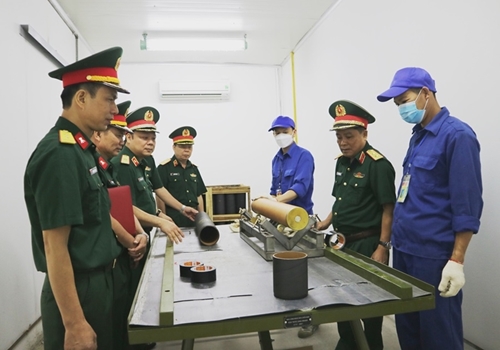According to Colonel Pham Quang Le, Political Chief of the Department of Weapons and Ammunition under the General Department of Technical Affairs, the campaign even plays a special role for the unit’s task performance.
The majority of the weapons and equipment managed by the department are different types of military ammunition. Meanwhile, stockpiles of ammunition are located in areas with tough weather conditions, while the military’s strategic-level sources of munitions are running out. Thus, good management of the quantity and quality of staffed weapons and ammunition is considered a forefront and conclusive work in meeting military units’ weapons and ammunition requirements for conducting training and combat readiness missions.
    |
 |
|
A delegation of the General Department of Technical Services inspects technical work at Depot KV1. |
Over the past years, the Department of Weapons and Ammunition has rolled out synchronous and drastic measures; actively proposed recommendations to higher levels to issue documents on managing weapons and ammunition; invested in information technology; and standardized systems of papers related to weapon and equipment management. The department is currently proposing to the Central Military Commission and the Ministry of National Defense (MND) to map out an array of projects to beef up units’ abilities in managing their staffed weapons and ammunition in the whole military.
At the same time, the Department of Weapons and Ammunition has paid due attention to human resources. It is clear to see that cadres and technicians are the core force in weapon and equipment management, especially when the unit is implementing a strategic-level project of re-planning the system of stockpiles and facilities in the military. Thus, building competence and political stance for technical cadres and employees plays a decisive role in the department’s task performance.
Recently, the Department of Weapons and Ammunition has implemented several projects to extend range, accuracy, and attack speed of weapons; and proposed the MND to agree on modern ammunition manufacturing processes. At the same time, the unit has attached much importance to heightening its staff’s competence to master the use of new weapons and equipment, and giving timely recommendations to higher levels to upgrade the system of stockpiles of weapons and ammunition.
Senior Colonel Bui Huy Ngoc, Second-in-command of the Department of Weapons and Ammunition, affirmed that the unit has also raised troops’ awareness of fire and explosion prevention and fighting. Particularly, the department has actively and proactively studied and given recommendations to higher levels to issue safety regulations and instructions, especially in stockpiles of ammunition; regularly checks and adjusts response plans in order to be ready in any circumstances; usually holds fire-fighting exercises; and directs affiliates to closely work with local authorities and relevant forces.
It is clear to say that the good implementation of Campaign 50 over the past time has contributed to effectively maintaining and managing weapons and ammunition in the whole military. In the following years, the Department of Weapons and Ammunition continues to mobilize, popularize, and roll out synchronous and drastic measures in order to more effectively implement the campaign, making contribution to meeting the demand to build an elite, compact, strong, and modern military.
Translated by Minh Anh